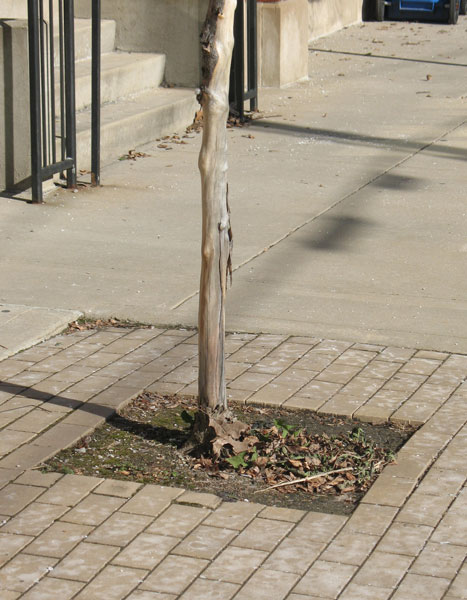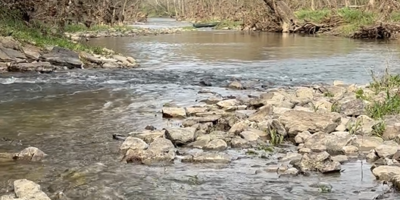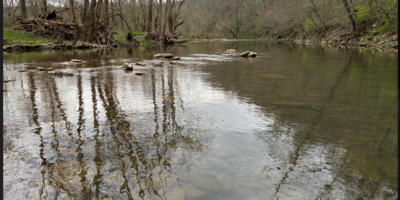By Dave Cooper
Because our little house in the Joyland neighborhood is about 50 years old and the backyard is pretty overgrown, we get lots of “volunteer” trees coming up in the fencerows and in the garden: hackberry, cherry, water maple, and the occasional oak or redbud. I don’t believe that trees and plants have feelings, but it still makes me feel bad to pull up a struggling little tree and throw it on the ground, where it will die a miserable, slow, and painful death from dehydration.

How to kill a tree: surround the trunk with bricks. North Limestone at Church St. Photo by Dave Cooper.
So about five years ago, I started trying to find new homes for all the little volunteer trees that came up in our yard. There are lots of good places to plant trees in Lexington. For example, because of sewage overflows and persistent flooding, the city of Lexington has bought up about a dozen homes in our neighborhood and torn them down. The city maintains the vacant lots by planting grass and keeping them mowed. But grass doesn’t absorb much rainfall, so it doesn’t do much to reduce the flooding.
These vacant lots are great places to plant water-loving volunteer trees. My partner Patty and I dig up the seedlings in our yard and place them in 5 gallon buckets, making sure not to expose the roots to the air, which dries the roots out and can kill the seedling. Then we push a wheelbarrow full of buckets over to the vacant lot, or median, or city park, and dig a hole, making sure that it is deep enough to allow the main tree root to point straight down (not curved). We mulch the tree, using grass clippings, wood chips, or leaves, and then place a five-inch long piece of black corrugated drain pipe around the base, to protect it from the city weed-whacker crews and the giant mower machines. Adding a wooden stake makes it look like an officially planted tree.
I have also planted trees in the front yards of vacant houses. I have planted trees in front of our neighborhood school, Mary Todd Elementary. Patty has planted many fruit trees in the Mary Todd Park. I have also planted many trees in other city’s parks: after our friend Stuart Butler passed away, the Bluegrass Group of the Sierra Club allocated $100 to plant a memorial tree in his town of Versailles. At that time, Patty and I had dozens of nice seedlings growing up around the backyard and in the compost pile, so we dug them all up, drove out to Versailles and planted 20 seedlings in the cute little city park behind the Woodford County Courthouse. Stuart was a good tree-hugger, and I think he would have been both pleased and amused by our little guerilla tree-planting raid on the city park.
Oh, I forgot to mention: I never ask permission from anybody before I plant these trees. Lexington’s trees are under attack, and guerilla tactics are the best way to fight back.
I have watched too many KU-sanctioned tree crews butcher trees underneath power lines. I have seen too many neighborhood trees mangled by topping, and I have seen downtown Lexington completely almost deforested over the past ten years. We used to have beautiful trees all along Main Street, providing cool shade in the summer for pedestrians and cyclists. During the holidays, these trees were filled with gorgeous twinkling little white lights. But during Mayor Isaac’s administration, nearly all the trees along Main Street were removed because they were supposedly overgrown.
It made me so sad and angry when the city did this. I counted the rings, and those nice downtown trees were about 35 years old, so the shade and green beauty those mature trees provided won’t return for a long time.
Neglect and abuse of our urban trees is everywhere you look in Lexington. Many downtown Lexington trees have been killed by laying bricks around the base, so the tree slowly dies of thirst. Trees in city parks are being accidentally killed by weed-whacking, which removes the bark and kills by girdling. During construction projects, heavy machinery around the base of mature trees compacts the soil and prevents the tree roots from getting the oxygen they need. I have even seen established mature trees completely encircled by newly-poured asphalt parking lots.
Then there are some unscrupulous tree companies, who solicit business door to door, frightening older homeowners by telling them that their mature shade trees are diseased and might fall onto their house at any minute: what they don’t tell the homeowners is that after charging them a healthy fee to remove the tree, they sell the firewood as a side business.
Many government maintenance people just don’t like trees—they only see the problems: trees interfering with power lines, buckling sidewalks, and the additional costs of leaf collection and clogged storm water sewer grates.
What most people never consider are the monetary benefits that a healthy urban forest provides. Trees clean and cool the air, provide home for songbirds, as well as beautify the city streetscape. Trees soak up rainwater, reducing flood run-off. Trees raise property values—real estate experts will tell you that each mature tree adds $5,000 to $10,000 to your home’s value. And, they reduce your utility bills by providing shade in the summer and blocking wind in the cold months.
And did you know that trees have been shown to lower crime? It’s because trees provide cool shade and lower the temperature in urban city areas—and any police officer will tell you that crime goes up with the temperature.
So I don’t ask permission anymore. I have guerilla-planted hundreds of trees around Lexington in the past five years, and plan to plant hundreds more. In April, I will be guerilla-planting native Bald Cypress trees in retention basins. Bald Cypress is a beautiful native swamp tree that soaks up water and doesn’t lose its branches, so this should help reduce some of the flooding around town.
Does this sound like fun? It would be great if you would do it, too.




Leave a Reply